Day-to-day Active Directory management involves many multi-step procedures that can take a lot of time and effort to execute. Adaxes significantly simplifies such activities with the help of Custom Commands, which transform any sequences of operations into one-click actions irrespective of their complexity and the number of steps involved. Such approach makes administration easier and quicker for the IT staff and even allows delegating complicated tasks to users and not worry that they will miss a step or do something wrong.
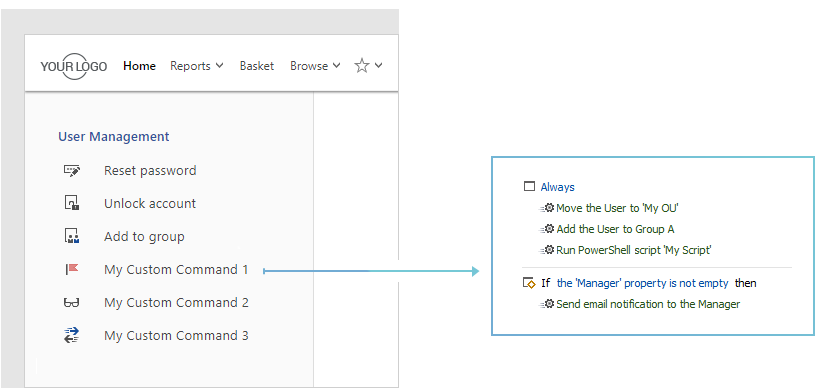
Some operations within Custom Commands can be executed only if certain conditions are met. It allows carrying out different sets of actions depending on the property values of AD objects, their location, group membership or any other criteria.
One of the most common scenarios where a Custom Command can be useful is user offboarding. Instead of manually executing all the operations required for terminating a user, like disabling the account, resetting the user’s password, revoking Office 365 licences and others, you can do all that with just one click. Adaxes even provides the Deprovision Custom Command, which is available straight out of the box.
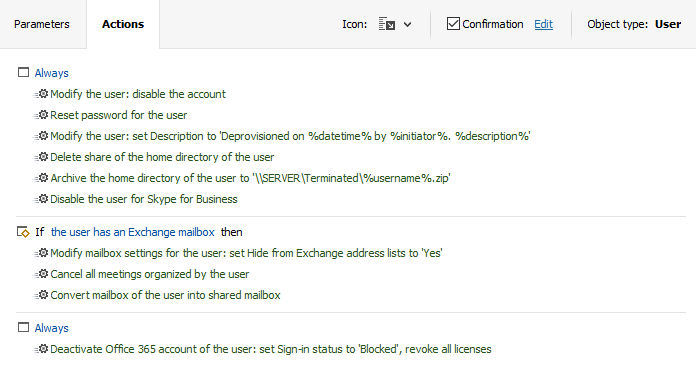
Parameters for Custom Commands
Custom Commands can also have parameters, which allows you to vary the execution process depending on the user input. This means that you can execute different sets of actions depending on the provided parameter values or use parameters in the actions themselves.
For example, you can give your HR staff a Custom Command that executes operations required to send users on vacation. When initiating the command, HR managers can then be asked to enter a return date for the user, which can be used to set the Out-Of-Office message, and to decide whether to disable the user account by checking a corresponding checkbox.

Using Scripts with Custom Commands
Custom Commands can also be used to run your own scripts straight from the user interface. This means you no longer need to switch to the command line to accomplish custom operations and you can even delegate the execution of scripts to non-technical staff, presenting them to users as yet another one-click action. As an additional benefit, Custom Commands can serve as a centralised place to store and manage all the scripts you need for day-to-day administration.
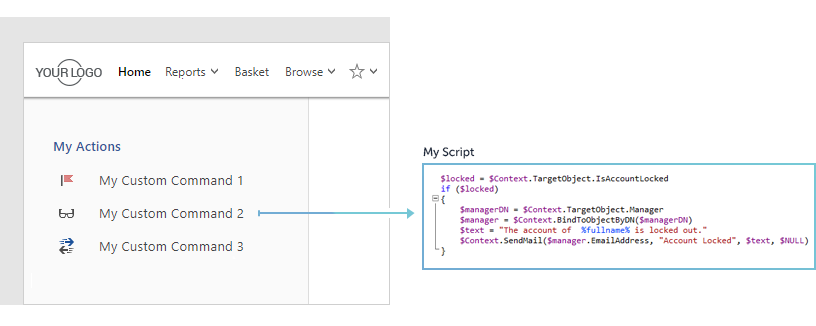
Delegation of Custom Commands
Adaxes allows you granularly control, which users can execute which commands on which objects. For example, IT staff can have access to all the Custom Commands, whereas help desk, managers, regular users and others can see only the commands they need for their specific job duties.
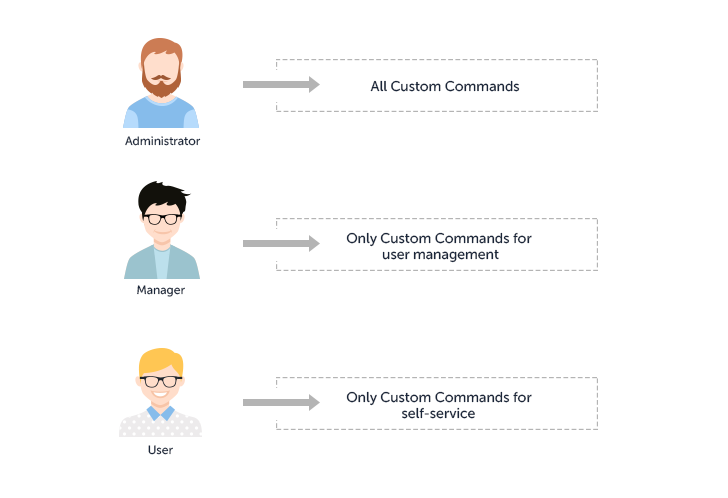
To delegate a Custom Command to users all you need to do is assign a single permission to execute a particular command and nothing more. You don’t need to grant rights to run every single step included in the procedure, which significantly reduces the risk of over-privileging your users.
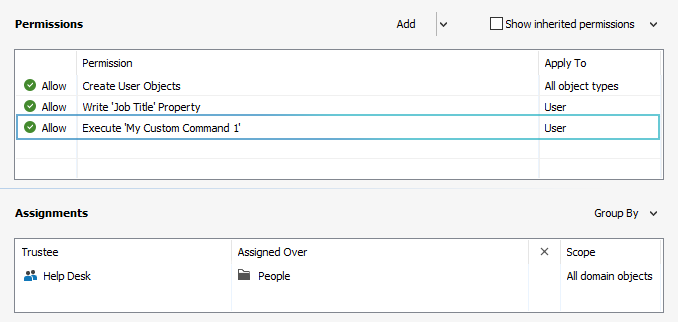
Approval-Based Workflow
Delegating certain tasks often requires additional control, for example, you might not want to execute the Deprovision command on any user accounts before an administrator reviews and approves it. This can be achieved by simply adding an approval step to the corresponding Custom Command.

Custom Commands in Automated Workflows
If the same set of actions needs to be executed in multiple automated workflows, you can share the logic between them by putting those actions in a Custom Command. For example, you can create a command that allocates users to OUs according to your policies and automatically execute it after creating new users, after updating existing accounts and on a regular basis.
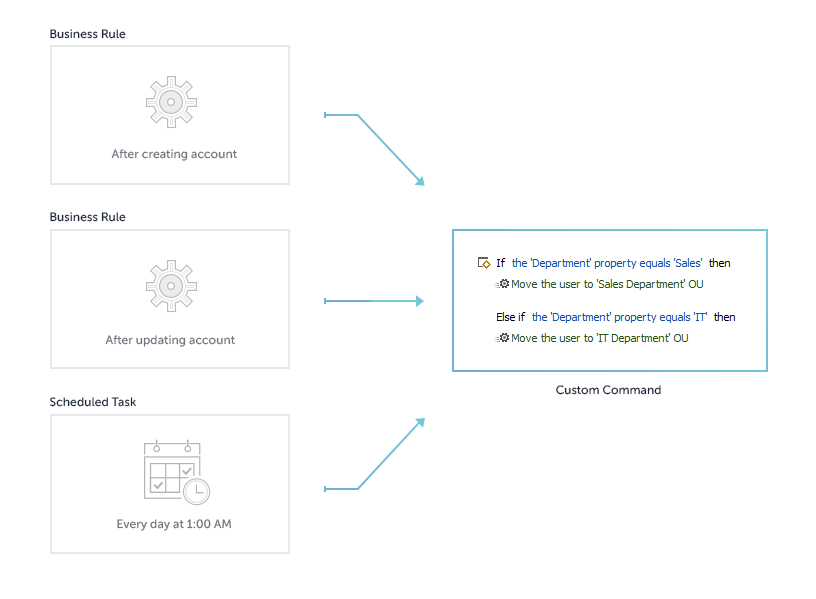
If at some point any of your policies change, all you need to do is edit a single Custom Command and the modifications will automatically apply to all the Business Rules and Scheduled Tasks it’s a part of.
So, at the end of the day, Custom Commands are a powerful tool to simplify everyday management for both technical and non-technical users, making complex multi-step management procedures more comprehensive, less prone to all sorts of errors and much easier to handle.
Other Features
Active Directory Management
Adaxes features a rule-based platform for Active Directory, Exchange and Office 365 automation, provides an enhanced web-based management environment, gives you a role-based access control model for delegating privileges, adds security with approval-based workflow, allows enforcing corporate data standards and much more.
More InfoActive Directory Automation
Adaxes provides rule-based automation for Active Directory, Exchange and Office 365. It allows executing sets of operations that are governed by if/else conditions before or after certain events in AD. So, for example, after the department of a user is changed, Adaxes can then automatically update the user’s group membership and send an email notification to the user’s manager, following the rules you define.
More InfoActive Directory Provisioning
Using condition-based rules you can automate the entire user provisioning process. Once a new user account is created in Active Directory, Adaxes will automatically execute the rest of onboarding procedures for you: moving the user account to a correct OU, adding it to necessary groups, creating and configuring an Exchange mailbox, assigning Office 365 licences, enabling the user for Skype for Business, creating and sharing a home folder, sending a welcome email, etc. Similarly to that, you can also automate all operations associated with user updates. Finally, when a user is terminated, Adaxes can automatically execute all the provisioning operations in reverse, ensuring instant and errorless offboarding.
More InfoWeb Interface for Active Directory
Adaxes Web Interface enables Active Directory management via a standard web browser. It features a modern responsive design, so users can access it on their laptops, tablets, phones or any other devices. You can set up different Web Interfaces specifically tuned for the needs of different job roles, like administrators, help desk, HR, managers, and others, giving them a clean and intuitive way to access the tasks they need. Adaxes Web Interface also incorporates Exchange and Office 365 management, so users get a single console without the need to learn and use multiple tools for their day-to-day routines.
More InfoWeb Interface Customisation
The Adaxes Web Interface is fully customisable, so you can configure it to have the exact views, forms, and operations that each user needs. For example, administrators can have a full set of management activities in Active Directory, Exchange and Office 365 across the entire environment, whereas managers can be set to view just their subordinates and only be able to update their group membership, assign Office 365 licences and change certain AD properties.
More InfoActive Directory Self Service
Adaxes Web Interface can act as a self-service portal for regular users. You can granularly specify, which operations they have access to, like updating their personal info, changing their own password, searching Active Directory, managing own group membership, updating Office 365 licences, etc.
More InfoActive Directory Password Self-Service
Adaxes Password Self-Service allows users to reset forgotten passwords and unlock accounts by themselves. To do that they need to go through a simple identity verification procedure that may involve answering security questions, SMS verification, using authenticator apps like Google Authenticator, Authy and others. A self-password reset can be accessed from the Windows logon screen, Adaxes Web Interface or it can be integrated into your own portal.
More InfoExchange Management and Automation
Adaxes automates Exchange mailbox management both on-premises and in Office 365. For example, after creating a new user account in Active Directory, Adaxes can automatically create an Exchange mailbox for the user. The database distribution of mailboxes can be done based on the first letter of the users’ surname, least number of mailboxes in the DB, the round-robin method, etc. Adaxes can then configure the mailbox, e.g. modify storage quotas or enable mailbox features like Unified Messaging or Archiving.
More InfoOffice 365 Automation and management
Adaxes can automatically assign and revoke Office 365 licences using condition-based rules. For example, when a new user is created in Active Directory, Adaxes can activate an account in Office 365 for the user and assign the necessary O365 licences according to the rules you define. Different licences can be assigned to different users based on their job title, department, location, etc.
More InfoActive Directory Role-Based Security
Adaxes introduces Role-Based Access Control for Active Directory, Exchange and Office 365. In a role-based delegation model, instead of assigning permissions to users, they are assigned to roles that correspond to actual job functions. So, when you need to change privileges for all users with the same job function, all you need to do is modify the permissions of the associated role. Assigning roles to users is done in a centralised manner, allowing you to easily control, who can do what and where. With role-based delegation, you can granularly specify, which parts of Active Directory are visible to users. For example, you can allow certain users to only view AD objects located in their own OU, while hiding the rest of the Active Directory structure from them.
More InfoApproval-Based Workflow
Adaxes allows you to add an approval step to practically any operation in Active Directory, Exchange and Office 365. For example, you can delegate user creation to HR, but after they fill in the form and click Create, Adaxes can suspend the operation and only proceed once a member of IT staff reviews and approves it. For more complex and security-sensitive scenarios, you can set up multi-level approvals. Such an approach allows delegating more tasks to lower level staff without taking the risk of losing control over them.
More InfoActive Directory Reports
Adaxes comes with reporting capabilities, allowing you to monitor and analyse what’s going on in your environment. Out of the box, you get more than 200 reports, which should cover the majority of your requirements. For more demanding scenarios Adaxes also provides various ways to create custom reports, including using your own scripts. It enables you to create reports of practically any complexity that can be specific to your organisation's needs. To deliver reports to users Adaxes supports centralised scheduling and also provides a self-scheduling option, allowing users to choose by themselves, which reports they want to receive and when.
More InfoCustom Commands for Active Directory
With Custom Commands users can launch complex multi-step operations in one go. For example, if you need to send a user on vacation, you can do it with just one click in the Web Interface. The operation can include steps like disabling the user account, adding it to a corresponding group, sending a notification to the user’s manager, etc. Such an approach allows you to delegate complicated tasks to users and not worry that they will miss a step or do something wrong. Besides, you don’t over-privilege them, as you only give out permissions to execute the Custom Command as a whole, not the individual steps it consists of. Administrators can also use Custom Commands in their day-to-day routines to make the management process simpler and accomplish the same results with a lot fewer clicks.
More InfoScheduled Tasks for Active Directory Management
Adaxes allows you to automate various routine management tasks by scheduling them. For example, it can automatically de-provision inactive accounts in AD, allocate users to necessary groups, maintain OU structure, etc. You can also schedule tasks like importing new users from CSV. Automating such a sensitive operation doesn’t mean that you need to sacrifice any control, as you can add an approval step to it. This way users will be created in AD only after a member of IT staff reviews and approves the operation. You can also use scheduled tasks to send various notifications to users, like reminders about their password or account expiration.
More InfoActive Directory Delegation
Active Directory management involves many different operations that require administrative privileges granted by default to AD administrators only. Though operations like password reset or account unlock are pretty simple, they take a lot of time of highly-skilled IT staff, not allowing them to focus on more complex and important issues. Active Directory delegation helps you optimise the productivity of the IT department by letting non-administrative users (e.g. department managers or Help Desk operators) perform certain administrative activities in Active Directory.
More Info

